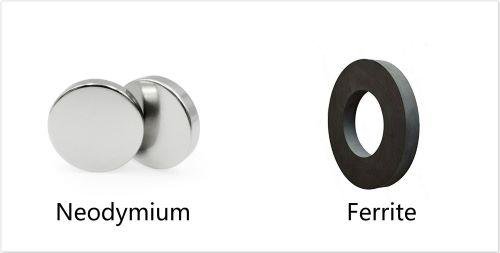Table of Contents
Introduction
Neodymium magnets have become a buzzword in recent years with increasing demand for this rare earth magnet. It is commonly used in many industries, from advanced technology such as new car manufacturing to everyday applications such as earphones, headphones, and Bluetooth. Here, this article is going to focus on its electroacoustic applications.
Figure 1 Neodymium Magnets
What Are Neodymium Magnets?
Neodymium magnets are one of the strongest permanent magnets on the market. These magnets with the chemical formula Nd2Fe14B are composed of neodymium, iron, and boron, and they have many unique properties.
- They are famous for being quite strong. Their magnetic force is ten times stronger than the second-strongest permanent magnet.
- Neodymium magnets are very light. Sufficient magnetic force can be obtained even with a small neodymium magnet.
- They are also very durable. Magnetic force decreases by 1% in 10 years. For more information on the strong magnetic performance of neodymium magnets, please refer to the table below.
Table 1 Magnetic Strength Comparison
| Magnet | Br (T) | Hci (kA/m) | TC | |
| (°C) | (°F) | |||
| Nd2Fe14B, sintered | 1.0–1.4 | 750–2000 | 310–400 | 590–752 |
| Nd2Fe14B, bonded | 0.6–0.7 | 600–1200 | 310–400 | 590–752 |
| SmCo5, sintered | 0.8–1.1 | 600–2000 | 720 | 1328 |
| Sr-ferrite, sintered | 0.2–0.78 | 100–300 | 450 | 842 |
How Are Neodymium Magnets Used in Electroacoustic Devices?
Neodymium magnets are commonly used in a variety of industries. These include electrical engineering, electroacoustic devices, transportation, and magnetic therapy. They are employed, for example, in the production of wind motors, magnetic levitation trains, and MRIs (Magnetic Resonance Imaging). In addition, these strong magnets are applied to the production of audio equipment. These audio devices include speakers, microphones, hearing aids, and more. The future of neodymium magnets is very broad and promising.
You may be unaware that neodymium magnets in mobile phones. Still, these small, powerful magnets work day and night, ensuring your phone’s electro-acoustic device runs smoothly. You can attach up to 14 small magnets to your phone. Each earbud or headset has 2-4 magnets. These magnets produce strong magnetic fields that convert electrical energy into mechanical energy. These magnets help improve the sound quality of your phone.
There are three ways neodymium magnets act as audio components in mobile phones.
- It’s very easy to find these magnets inside your phone’s speaker or receiver. Without a cell phone speaker, receiving a call is impossible.
- Earphones and headsets are external parts of mobile phones. It also helps create a pleasant user experience.
- Neodymium magnets provide strong power for autofocus cameras, vibration motors, and magnetic chargers.
Neodymium Magnets and Ferrite Magnets
With the development of technology, the mobile phone industry has increased the demand for mobile phone magnets. Neodymium magnets have replaced ferrite magnets and other conventional magnets. Yet, which is better for electroacoustic devices, neodymium magnet or ferrite magnet? Let’s discuss their advantages and disadvantages.
Figure 2 Neodymium Magnets and Ferrite Magnets
–Ferrite Magnets
Ferrite magnets have been used to make cell phone speakers for decades. They are made of ferromagnetic metal oxides and are considered non-permanent magnets. These magnets tend to have relatively low magnetism. Therefore, manufacturers usually use many ferrite layers to generate a strong magnetic field.
However, they are less expensive compared to comparable neodymium. Ferrite magnets are also highly resistant to wear and corrosion. Consequently, ferrite is the ideal choice for producing loudspeakers in harsh environments.
–Neodymium Magnet
Next, we will focus on the pros and cons of neodymium magnet mobile phone speakers.
First, the characteristic of neodymium magnets is their extreme magnetic force. Its magnetic energy value is about 18 times higher than a “regular” ferrite magnet. Neodymium speakers are also great in that they are lightweight. Weight is about 50% lighter than other speakers. In addition, there is less distortion even under extreme conditions. Neodymium magnets ensure excellent performance under various conditions. However,
Yet, NdFeB magnets are not resistant to high temperatures and corrosion and are fragile. Optimal working conditions are usually below 80°C.
Make Your Own Choice
We can conclude that neodymium magnets have a significant competitive advantage over ferrite and other magnets. If your phone needs strong permanent magnets, neodymium is the best choice.
You should also consider the following factors when choosing a suitable speaker for your mobile phone. Factors to consider include cost, efficiency, system weight, system size, and aesthetics. Stanford Magnets is a global supplier of a wide range of magnets. There are various types of permanent magnets.

